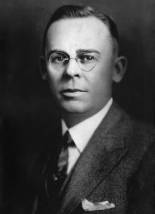Extinguished Luminaries of GSU: Robert R. Johnson

In the pantheon of distinguished GSU luminaries, the names of George Sparks (first president and recipient of the “Shining Light” award) and Wayne Kell (founder and first director) glow brightly. But there are other leaders and benefactors, now unfortunately forgotten, who were critical to the institution’s survival and growth. Robert Rosser Johnson is one of these.
The new Evening School of Commerce, as GSU was then known, relocated to the downtown Atlanta business district in 1914. Enrollment grew rapidly, requiring the school to move frequently. Rooms were rented in the following locations, with classes and school administration often sharing the same room:
• Walton Building (1914-1916)
• Peachtree Arcade (1917-1921)
• Murphy Building (1921-1926)
• 106 Forsyth Street NW (1926-1931)
The rooms at Forsyth Street were “dingy,” “overcrowded, ‘unsanitary,’ and a serious fire hazard.”1 As director Sparks searched for a new building, he found welcome support from Johnson, an Atlanta coal company executive. In spring 1930 the two men found a solidly constructed building at 223 Walton Street which, when renovated, could provide nineteen rooms for the growing student population. The student newspaper noted, “In addition to fourteen fine classrooms, four sanitary and modernly equipped rest rooms, study halls, reception rooms, the building is to house a modern coffee shop and a roof garden on top for recreation purposes….”2
Johnson became chief fundraiser as building committee chair. His task included raising $17,500 for the mortgage and an estimated $10,000 in services and building materials for renovation. It was not easy that hot summer, as the Depression took hold, but Johnson continued, month after month, serving also as unofficial purchasing agent and bursar.
When the completed building was dedicated in May 1931, Johnson had
• raised $33,528 in pledges and in-kind donations for the building fund;
• personally pledged $10,000 (by far the largest pledge of any donor);
• signed a note for $8,500 to cover unpaid invoices.
Nearly 700 students were enrolled in the fall, the largest number ever.
The Evening School, which rented classroom space in four locations over seven years, now had its own building. Sparks commented gratefully: “Homes throughout the land will be blessed because Robert Johnson and his loyal friends wrought well for those less fortunate—but who are now to have an attractive school home for modern business training.”3
Five years later—in 1936—Johnson paid off the remaining $14,000 indebtedness on the building. His personal contributions (in money, services, and kind) to the $80,000 building were estimated to be $40,000.
The next year, on December 10, 1937, Johnson died after a brief illness. He was 53 years old. Grieving students, now more than 1,100 strong, respectfully dedicated their 1938 Nocturne yearbook to Robert Rosser Johnson, “Friend and Benefactor of the Evening College.”

1 Reed, Educating the Urban New South, pp. 19-20
2 Technite, vol. 1, no. 2, October 20, 1930, p. 1.
3 Technite, vol. 1, no. 5, January 20, 1931, p. 3.
Archives and Library Sources Used:
- Merl E. Reed. Educating the Urban New South: Atlanta and the Rise of Georgia State University, 1913-1969.
- University Archives website, “Timeline,” Georgia State University Archives.
- Bertram Holland Flanders. A New Frontier in Education: The Story of the Atlanta Division, University of Georgia.
- Nocturne (yearbook), 1938. Georgia State University Archives.
- Lane Brothers Photographs, “223 Walton St.,” [ca. 1938]; and Georgia State University Photographs, “Walton Street” and “Robert Johnson.” Digital Collections, Special Collections and Archives Dept., Georgia State University Library.
- The Atlanta Constitution, May 7, 1931; October 18, 1936; December 11, 1937. ProQuest Historical Newspapers: The Atlanta Constitution, 1868-1945.
- Technite (student newspaper), October 20,1930; December 15, 1930; January 20, 1931. Georgia State University Archives.

